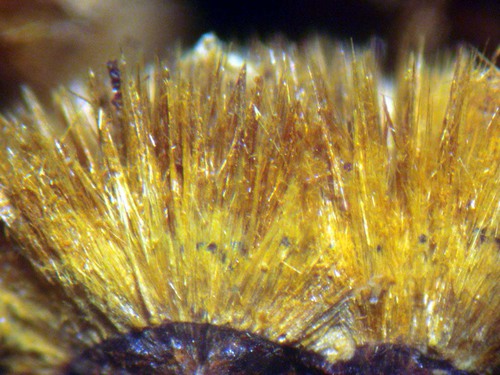Kapundaite
A valid IMA mineral species
This page is currently not sponsored. Click here to sponsor this page.
About Kapundaite
Formula:
NaCaFe4(PO4)4(OH)3 · 5H2O
Colour:
Pale to golden yellow
Lustre:
Silky
Hardness:
3
Specific Gravity:
2.93
Crystal System:
Triclinic
Name:
Named for Kapunda, Australia, the town closest to the type locality.
Unique Identifiers
Mindat ID:
39673
Long-form identifier:
mindat:1:1:39673:6
GUID
(UUID V4):
(UUID V4):
4ef25dc3-315f-43c1-895c-3714906f8fbd
IMA Classification of Kapundaite
Approved
IMA Formula:
CaNaFe3+4(PO4)4(OH)3 · 5H2O
Approval year:
2009
First published:
2010
Type description reference:
Mills, S. J., Birch, W. D., Kampf, A. R., Christy, A. G., Pluth, J. J., Pring, A., Raudsepp, M., Chen, Y. S. (2010) Kapundaite, (Na,Ca)2Fe3+4(PO4)4(OH)3·5H2O, a new phosphate species from Toms quarry, South Australia: Description and structural relationship to mélonjosephite. American Mineralogist, 95 (5) 754-760 doi:10.2138/am.2010.3466
Classification of Kapundaite
8.DH.80
8 : PHOSPHATES, ARSENATES, VANADATES
D : Phosphates, etc. with additional anions, with H2O
H : With large and medium-sized cations, (OH, etc.):RO4 < 1:1
8 : PHOSPHATES, ARSENATES, VANADATES
D : Phosphates, etc. with additional anions, with H2O
H : With large and medium-sized cations, (OH, etc.):RO4 < 1:1
42.11.28.
42 : HYDRATED PHOSPHATES, ETC.CONTAINING HYDROXYL OR HALOGEN
11 : (AB)3(XO4)2Zq·xH2O
42 : HYDRATED PHOSPHATES, ETC.CONTAINING HYDROXYL OR HALOGEN
11 : (AB)3(XO4)2Zq·xH2O
Mineral Symbols
As of 2021 there are now IMA–CNMNC approved mineral symbols (abbreviations) for each mineral species, useful for tables and diagrams.
| Symbol | Source | Reference |
|---|---|---|
| Kpd | IMA–CNMNC | Warr, L.N. (2021). IMA–CNMNC approved mineral symbols. Mineralogical Magazine, 85(3), 291-320. doi:10.1180/mgm.2021.43 |
Physical Properties of Kapundaite
Silky
Transparency:
Transparent, Translucent
Colour:
Pale to golden yellow
Streak:
Yellow
Hardness:
3 on Mohs scale
Hardness Data:
Estimated
Tenacity:
Flexible
Cleavage:
None Observed
Fracture:
Irregular/Uneven
Density:
2.93(3) g/cm3 (Measured) 2.917 g/cm3 (Calculated)
Optical Data of Kapundaite
Type:
Uniaxial (+)
RI values:
nα = 1.717(3) nβ = 1.737(3) nγ = 1.790(3)
2V:
Calculated: 64.7°
Max Birefringence:
δ = 0.073

Image shows birefringence interference colour range (at 30µm thickness)
and does not take into account mineral colouration.
and does not take into account mineral colouration.
Surface Relief:
High
Dispersion:
None observed
Optical Extinction:
Z = b, Y ≈ c.
Pleochroism:
Weak
Comments:
X = nearly colorless, Y = light brown, Z = pale brown.
Comments:
Absorption: Y > Z > X.
Chemistry of Kapundaite
Mindat Formula:
NaCaFe4(PO4)4(OH)3 · 5H2O
Crystallography of Kapundaite
Crystal System:
Triclinic
Class (H-M):
1 - Pinacoidal
Space Group:
P1
Cell Parameters:
a = 6.317(5) Å, b = 7.698(6) Å, c = 9.768(7) Å
α = 105.53(1)°, β = 99.24(2)°, γ = 90.09(2)°
α = 105.53(1)°, β = 99.24(2)°, γ = 90.09(2)°
Ratio:
a:b:c = 0.821 : 1 : 1.269
Unit Cell V:
451.2 ų
Z:
1
Morphology:
Type material:
The primary form is {100}. Other forms in the [010] zone are present, but cannot be measured. Flattened terminations suggest that {010} is also present.
The primary form is {100}. Other forms in the [010] zone are present, but cannot be measured. Flattened terminations suggest that {010} is also present.
Twinning:
None observed.
X-Ray Powder Diffraction
Powder Diffraction Data:
| d-spacing | Intensity |
|---|---|
| 9.338 Å | (100) |
| 7.442 Å | (37) |
| 5.173 Å | (52) |
| 3.828 Å | (45) |
| 3.123 Å | (34) |
| 2.817 Å | (33) |
| 2.753 Å | (64) |
| 2.417 Å | (48) |
Geological Environment
Paragenetic Mode(s):
| Paragenetic Mode | Earliest Age (Ga) |
|---|---|
| Near-surface Processes | |
| 21 : Chemically precipitated carbonate, phosphate, iron formations | |
| Stage 7: Great Oxidation Event | <2.4 |
| 47a : [Near-surface hydration of prior minerals] | |
| 47c : [Carbonates, phosphates, borates, nitrates] |
Type Occurrence of Kapundaite
General Appearance of Type Material:
Cavernous aggregates of fibers to several cm. Crystals are very thin flattened fibers to a few mm long, but only a few microns thick. The fibers occur in subparallel bundles, compact compact radial sprays, and feathery curving masses.
Place of Conservation of Type Material:
Co-type specimens:
Mineral Sciences Department, Natural History Museum of Los Angeles County, California, USA, catalog 62495.
Museum Victoria, Melbourne, Australia, number M51138.
Mineral Sciences Department, Natural History Museum of Los Angeles County, California, USA, catalog 62495.
Museum Victoria, Melbourne, Australia, number M51138.
Geological Setting of Type Material:
Phosphorite horizons in Cambrian marine sediments that were modified by metamorphism, followed by weathering and secondary enrichment.
Associated Minerals at Type Locality:
Reference:
Mills, S.J., Birch, W.D., Kampf, A.R., Christy, A.G., Pluth, J.J., Pring, A., Raudsepp, M., Chen, Yu-S. (2010): Kapundaite, a new phosphate species from Toms quarry, South Australia: description and structural relationship to mélonjosephite. American Mineralogist, 95, 754-760.
Synonyms of Kapundaite
Common Associates
Associated Minerals Based on Photo Data:
| 4 photos of Kapundaite associated with Goethite | α-Fe3+O(OH) |
| 3 photos of Kapundaite associated with Natrodufrénite | NaFe2+Fe3+5(PO4)4(OH)6 · 2H2O |
| 3 photos of Kapundaite associated with Phosphosiderite | FePO4 · 2H2O |
| 2 photos of Kapundaite associated with Stewartite | Mn2+Fe3+2(PO4)2(OH)2 · 8H2O |
| 2 photos of Kapundaite associated with Rhodochrosite | MnCO3 |
| 2 photos of Kapundaite associated with Mitridatite | Ca2Fe3+3(PO4)3O2 · 3H2O |
| 1 photo of Kapundaite associated with Leucophosphite | KFe3+2(PO4)2(OH) · 2H2O |
| 1 photo of Kapundaite associated with Cyrilovite | NaFe3+3(PO4)2(OH)4 · 2H2O |
| 1 photo of Kapundaite associated with Minyulite | KAl2(PO4)2F · 4H2O |
Related Minerals - Strunz-mindat Grouping
| 8.DH. | Ferroberaunite | Fe2+Fe3+5(PO4)4(OH)5 · 6H2O |
| 8.DH. | Rowleyite | [Na(NH4,K)9Cl4][V5+,4+2(P,As)O8]6 · n[H2O,Na,NH4,K,Cl] |
| 8.DH. | Ammoniotinsleyite | (NH4)Al2(PO4)2(OH) · 2H2O |
| 8.DH. | Thebaite-(NH4) | (NH4)3Al(C2O4)(PO3OH)2(H2O) |
| 8.DH. | Dendoraite-(NH4) | (NH4)2NaAl(C2O4)(PO3OH)2(H2O)2 |
| 8.DH. | Whiteite-(MnMnMn) | Mn2+Mn2+Mn2+2Al2(PO4)4(OH)2 · 8H2O |
| 8.DH. | Whiteite-(CaMnFe) | CaMnFe2Al2(PO4)4(OH)2 · 8H2O |
| 8.DH. | Hochleitnerite | Mn2Ti3(PO4)4O2(H2O)2 · 14H2O |
| 8.DH. | Regerite | KFe6(PO4)4(OH)7(H2O)6 · 4H2O |
| 8.DH. | Hydroxylbenyacarite | (H2O)2Mn2(Ti2Fe)(PO4)4[O(OH)](H2O)10 · 4H2O |
| 8.DH. | Macraeite | K(H2O)Mn2(Fe2Ti)(PO4)4[O(OH)](H2O)10 · 4H2O |
| 8.DH.05 | Minyulite | KAl2(PO4)2F · 4H2O |
| 8.DH.10 | Leucophosphite | KFe3+2(PO4)2(OH) · 2H2O |
| 8.DH.10 | Spheniscidite | (NH4,K)(Fe3+,Al)2(PO4)2(OH) · 2H2O |
| 8.DH.10 | Tinsleyite | KAl2(PO4)2(OH) · 2H2O |
| 8.DH.15 | Jahnsite-(CaMnFe) | {Ca}{Mn2+}{Fe2+2}{Fe3+2}(PO4)4(OH)2 · 8H2O |
| 8.DH.15 | Jahnsite-(CaMnMg) | {Ca}{Mn2+}{(Mg,Fe2+)2}{Fe3+2}(PO4)4(OH)2 · 8H2O |
| 8.DH.15 | Jahnsite-(CaMnMn) | {Ca}{Mn2+}{Mn2+2}{Fe3+2}(PO4)4(OH)2 · 8H2O |
| 8.DH.15 | Keckite | CaMn2+(Fe3+Mn2+)Fe3+2(PO4)4(OH)3 · 7H2O |
| 8.DH.15 | Rittmannite | {(Mn2+,Ca)}{Mn2+}{(Fe2+,Mn2+,Mg)2}{(Al,Fe3+)2}(PO4)4(OH)2 · 8H2O |
| 8.DH.15 | Whiteite-(CaFeMg) | {Ca}{(Fe2+,Mn2+)}{Mg2}{Al2}(PO4)4(OH)2 · 8H2O |
| 8.DH.15 | Whiteite-(CaMnMg) | {Ca}{Mn2+}{Mg2}{Al2}(PO4)4(OH)2 · 8H2O |
| 8.DH.15 | Whiteite-(MnFeMg) | {(Mn2+,Ca)}{(Fe2+,Mn2+)}{Mg2}{Al2}(PO4)4(OH)2 · 8H2O |
| 8.DH.15 | Jahnsite-(MnMnMn) | {Mn2+}{Mn2+}{Mn2+2}{Fe3+2}(PO4)4(OH)2 · 8H2O |
| 8.DH.15 | Kaluginite | (Mn2+,Ca)MgFe3+(PO4)2(OH) · 4H2O |
| 8.DH.15 | Jahnsite-(CaFeFe) | {Ca}{Fe2+}{Fe2+2}{Fe3+2}(PO4)4(OH)2 · 8H2O |
| 8.DH.15 | Jahnsite-(NaFeMg) | NaFe3+Mg2Fe3+2(PO4)4(OH)2 · 8H2O |
| 8.DH.15 | Jahnsite-(NaMnMg) | {(Na,Ca)}{(Mn2+,Fe3+)}{(Mg,Fe3+)2}{Fe3+2}(PO4)4(OH)2 · 8H2O |
| 8.DH.15 | Jahnsite-(CaMgMg) | {Ca}{Mg}{Mg2}{Fe3+2}(PO4)4(OH)2 · 8H2O |
| 8.DH.15 | Whiteite-(CaMnMn) | {Ca}{Mn2+}{Mn2}{Al2}(PO4)4(OH)2 · 8H2O |
| 8.DH.15 | Whiteite-(MnMnMg) | MnMnMg2Al2(PO4)4(OH)2 · 8H2O |
| 8.DH.15 | Jahnsite-(MnMnMg) | Mn2+Mn2+Mg2Fe3+2(PO4)4(OH)2 · 8H2O |
| 8.DH.15 | Jahnsite-(CaFeMg) | CaFe2+Mg2Fe3+2(PO4)4(OH)2 · 8H2O |
| 8.DH.15 | Jahnsite-(MnMnFe) | Mn2+Mn2+Fe2+2Fe3+2(PO4)4(OH)2 · 8H2O |
| 8.DH.15 | Whiteite-(CaMgMg) | CaMg3Al2(PO4)4(OH)2 · 8H2O |
| 8.DH.15 | Jahnsite-(MnMnZn) | Mn2+Mn2+Zn2Fe3+2(PO4)4(OH)2 · 8H2O |
| 8.DH.15 | Jahnsite-(NaMnMn) | NaMn2+(Mn2+Fe3+)Σ2Fe3+2(PO4)4(OH)2 · 8H2O |
| 8.DH.15 | Jahnsite-(CaMnZn) | CaMn2+Zn2Fe3+2(PO4)4(OH)2 · 8H2O |
| 8.DH.20 | Lun'okite | (Mn,Ca)(Mg,Fe,Mn)Al(PO4)2OH · 4H2O |
| 8.DH.20 | Manganosegelerite | (Mn2+,Ca)(Mn2+,Fe2+,Mg)Fe3+(PO4)2(OH) · 4H2O |
| 8.DH.20 | Overite | CaMgAl(PO4)2(OH) · 4H2O |
| 8.DH.20 | Segelerite | Ca2 Mg2 Fe3+2(PO4)4(OH)2 · 8H2O |
| 8.DH.20 | Wilhelmvierlingite | CaMnFe3+(PO4)2(OH) · 2H2O |
| 8.DH.20 | Juonniite | CaMgSc(PO4)2(OH) · 4H2O |
| 8.DH.25 | Calcioferrite | Ca2Fe3+2(PO4)3(OH) · 7H2O |
| 8.DH.25 | Kingsmountite | Ca3MnFeAl4(PO4)6(OH)4 · 12H2O |
| 8.DH.25 | Montgomeryite | Ca4MgAl4(PO4)6(OH)4 · 12H2O |
| 8.DH.25 | Zodacite | Ca4Mn2+Fe3+4(PO4)6(OH)4 · 12H2O |
| 8.DH.25 | Fanfaniite | Ca4MnAl4(PO4)6(OH)4 · 12H2O |
| 8.DH.30 | Arseniosiderite | Ca2Fe3+3(AsO4)3O2 · 3H2O |
| 8.DH.30 | Kolfanite | Ca2Fe3+3O2(AsO4)3 · 2H2O |
| 8.DH.30 | Mitridatite | Ca2Fe3+3(PO4)3O2 · 3H2O |
| 8.DH.30 | Pararobertsite | Ca2Mn3+3(PO4)3O2 · 3H2O |
| 8.DH.30 | Robertsite | Ca2Mn3+3(PO4)3O2 · 3H2O |
| 8.DH.30 | Sailaufite | (Ca,Na,◻)2Mn3+3(AsO4)2(CO3)O2 · 3H2O |
| 8.DH.35 | Mantienneite | KMg2Al2Ti(PO4)4(OH)3 · 15H2O |
| 8.DH.35 | Paulkerrite | K(Mg,Mn2+)2(Fe3+,Al,Ti,Mg)2Ti(PO4)4(OH)3 · 15H2O |
| 8.DH.35 | Benyacarite | (H2O)2Mn2Ti2Fe3+(PO4)4(OF)(H2O)10 · 4H2O |
| 8.DH.40 | Xanthoxenite | Ca4Fe3+2(PO4)4(OH)2 · 3H2O |
| 8.DH.45 | Mahnertite | NaCu3(AsO4)2Cl · 5H2O |
| 8.DH.50 | Andyrobertsite | KCdCu5(AsO4)4(H2AsO4) · 2H2O |
| 8.DH.50 | Calcioandyrobertsite | KCaCu5(AsO4)4(H2AsO4) · 2H2O |
| 8.DH.55 | Englishite | K3Na2Ca10Al15(PO4)21(OH)7 · 26H2O |
| 8.DH.60 | Bouazzerite | Bi6(Mg,Co)11Fe3+14(AsO4)18(OH)4O12 · 86H2O |
| 8.DH.65 | Galliskiite | Ca4Al2(PO4)2F8 · 5H2O |
| 8.DH.70 | Joteite | Ca2CuAl(AsO4)[AsO3(OH)]2(OH)2 · 5H2O |
| 8.DH.75 | Kampelite | Ba6Mg3Sc8(PO4)12(OH)6 · 7H2O |
| 8.DH.85 | Vaniniite | Ca2Mn2+3Mn3+2O2(AsO4)4 · 2H2O |
Fluorescence of Kapundaite
Not fluorescent
Other Information
Health Risks:
No information on health risks for this material has been entered into the database. You should always treat mineral specimens with care.
Internet Links for Kapundaite
mindat.org URL:
https://www.mindat.org/min-39673.html
Please feel free to link to this page.
Please feel free to link to this page.
Search Engines:
External Links:
Mineral Dealers:
References for Kapundaite
Reference List:
Mills, S. J., Birch, W. D., Kampf, A. R., Christy, A. G., Pluth, J. J., Pring, A., Raudsepp, M., Chen, Y. S. (2010) Kapundaite, (Na,Ca)2Fe3+4(PO4)4(OH)3·5H2O, a new phosphate species from Toms quarry, South Australia: Description and structural relationship to mélonjosephite. American Mineralogist, 95 (5) 754-760 doi:10.2138/am.2010.3466
Localities for Kapundaite
Locality List
 - This locality has map coordinates listed.
- This locality has map coordinates listed.
 - This locality has estimated coordinates.
ⓘ - Click for references and further information on this occurrence.
? - Indicates mineral may be doubtful at this locality.
- This locality has estimated coordinates.
ⓘ - Click for references and further information on this occurrence.
? - Indicates mineral may be doubtful at this locality.
 - Good crystals or important locality for species.
- Good crystals or important locality for species.
 - World class for species or very significant.
(TL) - Type Locality for a valid mineral species.
(FRL) - First Recorded Locality for everything else (eg varieties).
- World class for species or very significant.
(TL) - Type Locality for a valid mineral species.
(FRL) - First Recorded Locality for everything else (eg varieties).
All localities listed without proper references should be considered as questionable.
Australia (TL) | |
| Mills et al. (2010) |
France | |
| Gayraud et al. (2011) |
Italy | |
| Vignola et al. (2018) |
USA | |
| - (n.d.) +4 other references |
Quick NavTopAbout KapundaiteUnique IdentifiersIMA Classification Classification Mineral SymbolsPhysical Properties Optical Data Chemistry Crystallography X-Ray Powder DiffractionGeological EnvironmentType Occurrence SynonymsCommon AssociatesStrunz-MindatFluorescence Other InformationInternet Links References Localities Locality List





 symbol to view information about a locality.
The
symbol to view information about a locality.
The 



Tom's Quarry, Kapunda, North Mt Lofty Ranges, Mt Lofty Ranges, South Australia, Australia